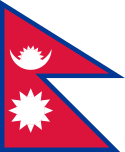Miss Earth 2002
| Data: | 29 października 2002 |
|---|---|
| Kraj: | |
| Miasto: | Pasay |
| Gala finałowa: | Folk Arts Theater |
| Liczba uczestniczek: | 53 |
| Zwyciężczyni: | Winfred Omwakwe |
| Poprzedniczka: | Catharina Svensson |
| Następczyni: | Dania Prince |
Miss Earth 2002 – drugi konkurs Miss Earth. Odbył się on 29 października 2002 roku w Folk Arts Theater, w Pasay na Filipinach. W konkursie wzięły udział 53 uczestniczki. Dzięki temu konkurs Miss Earth stał się 3. na świecie pod względem liczby uczestniczek. Tytuł Miss Earth 2002 zdobyła reprezentantka Bośni i Hercegowiny. Jednak 28 maja 2003 r. z powodu niewywiązywania się z postanowień kontraktu jej obowiązki przejęła 1. wicemiss - Winfred Omwakwe, reprezentantka Kenii[1][2]. Winfred Omwakwe została oficjalnie koronowana na Miss Earth 2002 7 sierpnia 2003 r. w Carousel Gardens, w Mandaluyong City na Filipinach[3][4]. Wśród 23 debiutujących w konkursie państw znalazła się Polska, którą reprezentowała Agnieszka Portka.
Rezultat finałowy
| Wyniki finału | Uczestniczka |
|---|---|
| Miss Earth 2002 |
|
| Miss Powietrza (1. wicemiss) |
|
| Miss Wody (2. wicemiss) |
|
| Miss Ognia (3. wicemiss) |
|
| Półfinalistki |
Nagrody specjalne
| Nagroda specjalna | Uczestniczka |
|---|---|
| Miss Fotogeniczności | |
| Najlepszy Kostium Narodowy | |
| Miss Przyjaźni | |
| Miss Talentu | |
| Najładniejsza w stroju kąpielowym | |
| Najładniejsza w sukni wieczorowej |
Uczestniczki
|
|
Przypisy
- ↑ Ricardo F. Lo, Vanzi, Sol Jose: Kenyan is Miss Earth. Philippine Headline News Online/Philippine Star, 11 sierpnia 2003. [dostęp 2010-07-25]. (ang.).
- ↑ Emma Cowing: Green Godesses. The Scotsman, Scotland, 13 maja 2008. [dostęp 2010-07-25]. (ang.).
- ↑ Giovanni Paolo J. Yazon: Miss Kenya is now Miss Earth. Manila Standard Today, 14 sierpnia 2003. [dostęp 2010-07-25]. (ang.).
- ↑ Ricardo F. Lo: A Gallery of Black Beauty Queens. The Philippine Star, 10 grudnia 2008. [dostęp 2010-07-25]. (ang.).
Linki zewnętrzne
- Strona oficjalna Miss Earth. (ang.).
- Oficjalne wyniki Miss Earth 2002. (ang.).
Media użyte na tej stronie
Flag of Serbia and Montenegro, was adopted on 27 April 1992, as flag of Federal Republic of Yugoslavia (1992-2003).
Flag of Serbia and Montenegro, was adopted on 27 April 1992, as flag of Federal Republic of Yugoslavia (1992-2003).
Łatwo można dodać ramkę naokoło tej grafiki
Flaga Finlandii
Autor: Pedro A. Gracia Fajardo, escudo de Manual de Imagen Institucional de la Administración General del Estado, Licencja: CC0
Flaga Hiszpanii
Flag of Gibraltar
Flag of Albania
The flag of the Dominican Republic has a centered white cross that extends to the edges. This emblem is similar to the flag design and shows a bible, a cross of gold and 6 Dominican flags. There are branches of olive and palm around the shield and above on the ribbon is the motto "Dios,Patria!, Libertad" ("God, Country, Freedom") and to amiable freedom. The blue is said to stand for liberty, red for the fire and blood of the independence struggle and the white cross symbolized that God has not forgotten his people. "Republica Dominicana". The Dominican flag was designed by Juan Pablo Duarte, father of the national Independence of Dominican Republic. The first dominican flag was sewn by a young lady named Concepción Bona, who lived across the street of El Baluarte, monument where the patriots gathered to fight for the independence, the night of February 27th, 1844. Concepción Bona was helped by her first cousin María de Jesús Pina.
Flag of Ethiopia
The Flag of India. The colours are saffron, white and green. The navy blue wheel in the center of the flag has a diameter approximately the width of the white band and is called Ashoka's Dharma Chakra, with 24 spokes (after Ashoka, the Great). Each spoke depicts one hour of the day, portraying the prevalence of righteousness all 24 hours of it.
Flag of Canada introduced in 1965, using Pantone colors. This design replaced the Canadian Red Ensign design.
The flag of Navassa Island is simply the United States flag. It does not have a "local" flag or "unofficial" flag; it is an uninhabited island. The version with a profile view was based on Flags of the World and as a fictional design has no status warranting a place on any Wiki. It was made up by a random person with no connection to the island, it has never flown on the island, and it has never received any sort of recognition or validation by any authority. The person quoted on that page has no authority to bestow a flag, "unofficial" or otherwise, on the island.
The national flag of Kingdom of Thailand since September 2017; there are total of 3 colours:
- Red represents the blood spilt to protect Thailand’s independence and often more simply described as representing the nation.
- White represents the religion of Buddhism, the predominant religion of the nation
- Blue represents the monarchy of the nation, which is recognised as the centre of Thai hearts.
State Flag of Venezuela 1930-2006, New flag was introduced 13 March 2006.
The flag of the United Kingdom (3:5 version). This flag is the Union Flag in the 3:5 ratio exclusively used on land. At sea, the correct ratio is 1:2.






















































